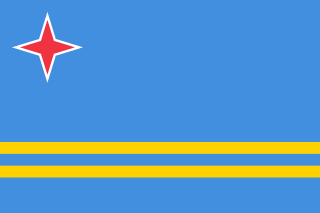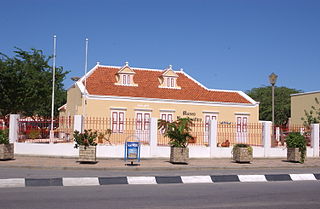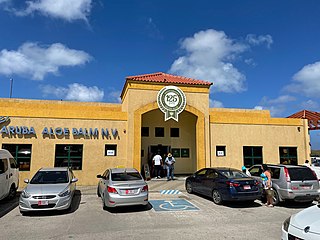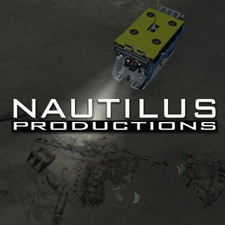
Aruba, officially the Country of Aruba, is a constituent country within the Kingdom of the Netherlands, in the southern Caribbean Sea 29 kilometres (18 mi) north of the Venezuelan peninsula of Paraguaná and 80 kilometres (50 mi) northwest of Curaçao. In 1986, it became a constituent country within the Kingdom of the Netherlands and acquired the formal name the Country of Aruba.

Oranjestad, the capital and most populous of Aruba's eight regions, is located on the southwestern coast of the island. In Papiamento, the local language, Oranjestad is commonly referred to as "Playa" by the locals.
The Aruba national football team is the national team of Aruba. It was founded in 1932 and is affiliated with the Caribbean Football Union (CFU), CONCACAF and FIFA and is controlled by the Arubaanse Voetbal Bond.
The florin or Aruban guilder is the currency of Aruba. It is subdivided into 100 cents. The florin was introduced in 1986, replacing the Netherlands Antillean guilder at par. The Aruba currency exchange rate for U.S. dollars is Afl. 1.77 for cash and Afl. 1.78 for traveller's checks. Most supermarkets and gas stations use the exchange rate of Afl. 1.75, while many restaurants and shops use the exchange rate of Afl. 1.80.

Ehud Netzer was an Israeli architect, archaeologist and educator, known for his extensive excavations at Herodium, where in 2007 he found the tomb of Herod the Great; and the discovery of a structure defined by Netzer as a synagogue, which if true would be the oldest one ever found.
The Aruba national korfball team is managed by the Korfball Bond Aruba (KBA), representing Aruba in korfball international competitions.

The Gozo Museum of Archaeology is a museum in the Cittadella, the oldest part of the city, of Victoria in Gozo, Malta. The museum of Archaeology was opened in 1960 as the first public museum in Gozo and was known as the Gozo Museum. The museum was redesigned and reopened in 1986 as the Archaeology Museum of Gozo. Today it is known as the Gozo Museum of Archaeology or the National Museum of Archaeology. The museum features archaeological artifacts and relics and displays covering the cultural history of the Island of Gozo from the prehistoric era to the early modern period. Its exhibits include the Maymūnah Stone.

The Caribbean Netherlands is a geographic region of the Netherlands located outside of Europe, in the Caribbean, consisting of three special municipalities. These are the islands of Bonaire, Sint Eustatius, and Saba, as they are also known in legislation, or the BES islands for short. The islands are officially classified as public bodies in the Netherlands and as overseas territories of the European Union; as such, European Union law does not automatically apply to them.

The Historical Museum of Aruba is a historical museum in the city of Oranjestad in Aruba. It explains the history of the island and its inhabitants, in rural and urban areas.

The Numismatic Museum of Aruba is a former numismatic museum in the city of Oranjestad in Aruba. It was founded by J. Mario Odor and was opened on 13 November 1981. The collections included coins, paper money, and stamps of Aruba and other countries. The museum is now closed.
The Museum of Antiquities Aruba is a museum in Paradera in the outskirts of Oranjestad in Aruba. The museum covers from the preceramic era to the 20th century.

Royal Aruba Aloe is a company in Aruba that cultivates and produces aloe-derived products. It also contains its own aloe museum.
The Model Trains Museum is a private museum in the town of San Nicolaas in Aruba. It covers the history of train traffic from 1875 to the present. The museum is on the ground floor of a private residence, and includes model trains from England, Germany, the U.S., and Canada, and a number of model planes and automobiles as well.
Caquetío is an extinct Arawakan language family. The language was spoken along the shores of Lake Maracaibo, in the coastal areas of the Venezuelan state of Falcón, and on the Dutch islands of Aruba, Bonaire and Curaçao.

The Bonaire national football team is the national football team of the Caribbean island of Bonaire, a public body of the Netherlands. It is under the control of the Bonaire Football Federation. It became a member of the CFU and an associate member of CONCACAF on 19 April 2013. after which it became a full CONCACAF member on 10 June 2014 The team can participate in the CONCACAF Gold Cup and Caribbean Cup because of their membership in the confederation and sub-confederation. However, Bonaire is not a member of FIFA and therefore can not compete in the FIFA World Cup or other FIFA events.

Aruba competed at the 2015 Pan American Games in Toronto, Ontario, Canada from July 10 to 26, 2015.

Nautilus Productions LLC is an American video production, stock footage, and photography company incorporated in Fayetteville, North Carolina in 1997. The principals are producer/director Rick Allen and photographer Cindy Burnham. Nautilus specializes in documentary production and underwater videography, and produced QAR DiveLive, a live webcast of underwater archaeology filmed at the wreck of the Queen Anne's Revenge in 2000 and 2001.

Alanya Archaeological Museum is an archaeological museum in Alanya, Turkey. The museum is divided into two sections, with displays of archaeological and ethnographic artifacts. It contains numerous ceramic, marble, bronze and glass pieces and mosaics from the Hellenistic, Roman, and Byzantine periods. Of particular note is its 2nd century bronze statue of Hercules, which measures 52 centimetres (20 in) in height. The museum, which was established in 1967, was refurbished in 2012.













